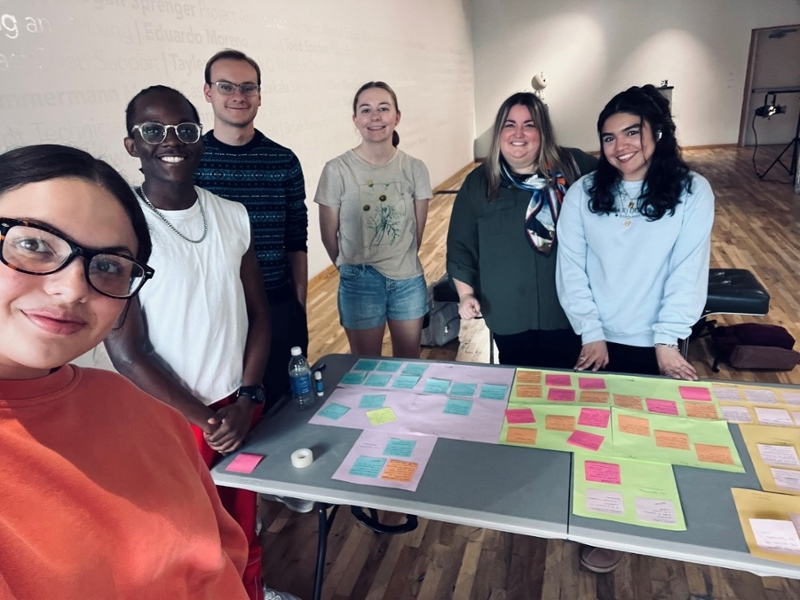
Download Image: Web
As part of Hispanic Heritage Month, Maybel Mesa Morales, Ph.D., assistant professor of Spanish at Lycoming College, decided to get her students out of the classroom and into the College’s downtown Williamsport art gallery. The Spanish 426 class observed Sarah Blood’s “Now is the Time” exhibition, which explored themes such as isolation, power structures, and inequality through innovative uses of light and space, aligning perfectly with the Latin American socio-political issues the class has been discussing.
The students in this high-level Spanish course, entitled “Dictatorships and Violence in Latin America and Iberia through Literature, Theater, and Film,” explore the intersections of dictatorship, violence, memory, and trauma in the Hispanic world through literature, film, and theater. Students analyze how artistic representations both preserve and challenge memories and traumas of dictatorship, spanning from Francoist Spain to Latin American dictatorships, while also examining the construction of narratives within Hispanic cultural landscapes. Themes such as censorship, exile, and the politics of memory are explored through theoretical lenses from postcolonial and cultural studies. Through critical engagement with canonical and lesser-known works, students gain insight into how these literary texts, cinematic works, and dramatic productions bear witness to historical injustices and foster processes of healing and reconciliation, enhancing their understanding of the enduring legacies of dictatorship and violence while considering ethical and aesthetic dimensions.
“This activity provided not only an opportunity to engage with contemporary art but also a platform for students to further develop their transcultural and translingual competence."
During the visit, students engaged in an activity that required them to analyze Blood’s artwork both visually and conceptually, all while using Spanish. The students followed a structured analysis that included three key steps: visual description, conceptual interpretation, and personal reflection. They worked with color-coded paper and sticky notes—yellow for visual description, green for conceptual interpretation, and purple for personal opinion—where they wrote brief responses to guide their analysis.
Once the responses were completed, students combined their notes to create mini posters summarizing their thoughts on the artwork. Each student then presented their analysis alongside the artwork they had selected, while their peers offered additional comments and questions, encouraging an interactive and collaborative learning experience. At the end of the session, the entire group came together to draw broader conclusions about the role of light and darkness in Blood’s work, as well as the social and political themes explored.
“They connected their observations to the historical and political frameworks they’ve been studying,” explained Morales. “This activity provided not only an opportunity to engage with contemporary art but also a platform for students to further develop their transcultural and translingual competence. By reflecting on art and social issues through another language, they deepened their understanding of cultural perspectives and enhanced their ability to communicate across cultures.”
Morales said that through their analyses, students explored how art can raise awareness about critical topics like marginalization and systemic injustice—key themes both in the exhibition and the course. Conducting this activity during Hispanic Heritage Month added an extra layer of significance, encouraging students to consider the intersections of art, language, and culture, and how they shape our understanding of social and political realities in Latin America and beyond.
The experience not only strengthened their Spanish language proficiency but also expanded their ability to think and analyze critically in a transcultural context – competencies essential for understanding how different cultural lenses influence social critique and foster meaningful dialogue.
“For me, the Lycoming Art Gallery provided a meaningful way to extend learning beyond the confines of the classroom and into the heart of the community. It was incredibly rewarding to see my students engage with art in a public space, where academic discussions about power and inequality became part of a broader societal conversation. This experience reinforced my belief in the importance of community engagement, showing how connecting academic work to real-world issues deepens students' understanding and helps them see the relevance of what we explore in class in everyday life,” she said.
Overall, the exhibition offered a dynamic platform for students to develop their critical thinking while honing their Spanish skills, reinforcing the importance of transcultural and translingual competence in today’s interconnected world.”